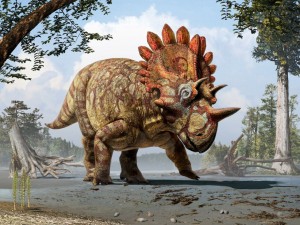
Scientists have discovered the skull of a new dinosaur, a feathered relative of the Triceratops, according to new findings released in Current Biology today.
Now, we know what you may be thinking – we don’t normally cover science news. We’re writing about this paper because of a little note we saw in the acknowledgements:
C.M.B. would specifically like to highlight the ongoing and unwavering support of Lorna O’Brien. Lorna, will you marry me?
That’s right – first author Caleb M. Brown, based at the Royal Tyrrell Museum of Palaeontology in Drumheller, Alberta, proposed to his girlfriend in his paper.
It’s the first time we’ve come across such an unusual acknowledgement, but we are sure this – or something similar – has happened before. The question is: Will she say yes?? We’ve reached out to Brown, and will try to keep you posted. [Update: We’re told that she did say yes.]
A spokesperson for Cell Press, the publisher of Current Biology, said the publisher is on board with the move:
Current Biology is aware of the proposal and we are wishing the very best for the couple. I checked with several editors and this is a first for Current Biology as well as Cell Press.
Beyond that, “A New Horned Dinosaur Reveals Convergent Evolution in Cranial Ornamentation in Ceratopsidae” has some interesting findings.
Here’s more from the publisher’s press release about the paper:
“The specimen comes from a geographic region of Alberta where we have not found horned dinosaurs before, so from the onset we knew it was important,” says Dr. Caleb Brown of the Royal Tyrrell Museum of Palaeontology in Alberta, Canada. “However, it was not until the specimen was being slowly prepared from the rocks in the laboratory that the full anatomy was uncovered, and the bizarre suite of characters revealed. Once it was prepared it was obviously a new species, and an unexpected one at that. Many horned-dinosaur researchers who visited the museum did a double take when they first saw it in the laboratory.”
Brown likes to say, only partly in jest, that the uniqueness of this specimen was so obvious that you could tell it was a new species from 100 meters away.
What made this new horned dinosaur distinctive was the size and shape of its facial horns and the shield-like frill at the back of the skull. This new species is similar in many respects to Triceratops, except that its nose horn is taller and the two horns over its eyes are “almost comically small.” But the new dinosaur’s most distinctive feature is that frill, including what Brown describes as a halo of large, pentagonal plates radiating outward, as well as a central spike. “The combined result looks like a crown,” he says.
Hat tip: News staff at Science
Like Retraction Watch? You can make a one-time tax-deductible contribution or a monthly tax-deductible donation to support our work, follow us on Twitter, like us on Facebook, add us to your RSS reader, or subscribe to our daily digest. If you find a retraction that’s not in our database, you can let us know here. For comments or feedback, email us at [email protected].
Assuming O’Brien accepts, I wish them a long and enjoyable life together.
They could publish the banns in the next (joint-) article.
She did say yes! http://news.sciencemag.org/paleontology/2015/06/hellboy-dino-was-close-relative-triceratops
I am glad to hear that she didn’t respond with an expression of concern that would have resulted in his being forced to retract.
I have to say I am glad that the paper didn’t take years to go through the system and the author didn’t have to wait too long to pop the question!!
Received: March 14, 2015; Received in revised form: April 20, 2015; Accepted: April 20, 2015; Published Online: June 04, 2015
This being Retraction Watch, let’s hope for the couple’s future that the paper will not be retracted
How scientist’s propose: Will you be my next experiment?
“Let us generate supplementary data together!”
a feathered relative of the Triceratops
I query this part of the post. is there an emoticon for my Expression of Concern?
Fixed, thanks!
Hooray!
The logical endpoint of this is that people will start competing to get their marriage proposals published in “better quality/more selective” journals with higher impact factors.
A journal’s Impact factor should definitely include the number of marriage proposals.
Well, that’s one way to determine if she was really reading his publications.
This Research article have shown the best way to Young unmarried scientists to propose his girlfriend. Hope in future research article will remain as a research article instead of being a love letter. Otherwise, unmarried scientists will start to use research article in the form of published love proposal.
Fazil, with all due respects, did you read how the proposal was presented? It was in the acknowledgement section and not part of the actual research. I doubt very seriously that any person would comment to several years of research with the intent of writing a love letter to their girl friend, though I can think of at least two physicists who used what we could call dates to explain the cosmology and the electromagnetic spectrum.
it appears that most are ok with such personal issues publicized in a scientific journal. fast forward – if the arrangement made here fails in real life, would the sentence be retracted?
When for the first time i propose to a girl , she said you should speak with my father and get his consent. Her father ask me son what do you have in your life? I tell her father that i have a university degree and a bunch of published papers. Her father laughed at me and kicked me out of his home.